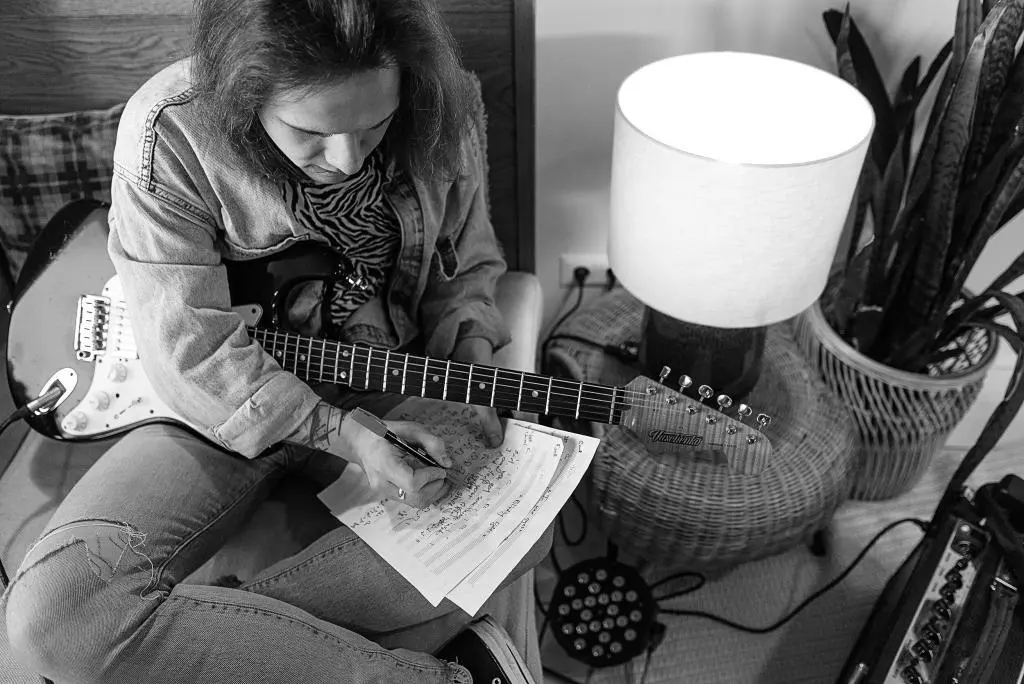Music publishing simply refers to the business of promoting, licensing and collecting royalties for original music compositions.
Music publishers act as intermediaries between songwriters and various entertainment industries to get songs used in films, ads, video games, and other media.

What is Music Publishing: Table of Contents
The core roles in music publishing include publishers, songwriters, composers, artists, and producers. Publishers find talent, provide funding and industry connections, and handle the business side of things. Songwriters and composers create the raw musical works and lyrics. Recording artists and producers then record and produce commercially viable songs and master recordings.
Music publishing deals and contracts are hugely important because they determine ownership rights and how songwriting royalties will be split between creators and publishers. Traditionally, physical sheet music publishing was a core part of the industry. But today, music publishing focuses on managing song rights, licensing songs for various uses, collecting royalties, and distributing them to writers and rights holders.
Modern music publishers act as business and licensing partners for songwriters in the complex music industry. They provide advance funding, industry clout, and administrative support to creatives so musicians can focus on writing songs. Music publishing income has become a vital revenue stream for many artists and songwriters alongside sales from recordings and concert tickets. Understanding the nuances of rights ownership and music royalties is crucial.
With the right publishing deal and team, songwriters can earn substantial income from their compositions through mechanical, public performance, and synchronization royalties. But predatory contracts or shady industry players can also take advantage of writers. Learning the landscape of music publishing is key to protecting your rights and getting properly valued as a musical creator.

What Does a Music Publisher Do?
Music publishers play a multifaceted role in the industry acting as business partners, advocates, and administrators for songwriters. Their core responsibilities include:
- Finding and developing musical talent. Publishers scout out promising songwriters and provide coaching, feedback, industry connections, and funding to help creatives hone their craft. Nurturing the next generation of hitmakers is a key publishing function.
- Protecting copyrights and collecting royalties. Publishers register songs with performing rights organizations (PROs) like ASCAP and BMI to ensure writers get paid when their music gets used. They monitor where songs get played and ensure proper royalty payments.
- Promoting songs and licensing for various uses. Publishers pitch songs for film/TV placement, commercial licensing, and other sync opportunities. Placement in ads, movies, or shows is highly lucrative.
- Administering song rights and ownership data. Publishers document songwriter splits, maintain registration databases, and distribute royalty payments accurately. Complex ownership data must be diligently managed.
- Supporting songwriters creatively and financially. Many publishers provide studio access, co-writing opportunities, and career guidance to signed writers. They also offer livable advances so writers can focus on music full-time.
In essence, publishers handle the business side so musicians can concentrate on creativity. They leverage industry connections and relationships to get songs placed in lucrative licensing deals. Publishers act almost like agents or managers for songwriters in many regards. For hit songs, they ensure the writers are rightfully compensated for their work.
Key Concepts in Music Publishing
To maximize income potential and protect creative work, songwriters must understand some of the fundamental concepts that govern music publishing. Here are some of the most important ideas and practices to be aware of:
Copyrights
For music creators, having a solid grasp of copyright law is crucial to fully benefiting from publishing. Copyright grants composers exclusive rights over original works like songs, providing the legal grounds to protect your assets and get paid when your music gets used.
Music compositions actually contain layers of separate copyrightable elements – the underlying melody, arrangement, rhythm, and lyrics are all individually protected. Even distinctive instrumental riffs or original hook phrases hold standalone value.
Furthermore, your song title and the finished composition itself are copyrighted works. Understanding these layers of interlaced rights allows publishers to license compositions for various uses and maximize income potential. Sync licensing opportunities often revolve around memorable lyrics or melodies, even separate from the full recording.
Registering your catalog with a Performing Rights Organization (PRO) like ASCAP or BMI is vital for properly collecting royalties and enforcing your copyrights.
PRO registration puts your ownership on file and empowers collective licensing – your works get tracked whenever they are publicly performed, and royalties collected on your behalf. Regular online royalty statements provide transparency.
Unregistered songs won’t be monitored by PROs, leading to lost income if used publicly. Don’t sleep on registration if you want to actually collect what you’ve earned.
Furthermore, PRO registration enables copyright enforcement. Your songs become searchable in the PRO database, enabling screening against unlicensed set lists or covers. PROs issue takedowns and legal actions on behalf of members.
Overall, understanding music copyrights allows you to fully benefit from the protection, licensing vehicles, performance tracking, and royalty collection systems publishers provide. Knowledge brings compensation.
Royalties
For music creators, royalties represent the bread and butter – the compensation you earn when your work gets used in the commercial marketplace. Fully grasping the royalty concept is essential for maximizing publishing revenue.
Mechanical royalties arise any time a composition is mechanically reproduced and distributed, whether on physical formats like CDs and vinyl or digital formats like downloads and streams. The rates are based on unit sales and stream counts.
Performance royalties come from whenever a song is publicly performed in mediums like retail stores, restaurants, radio, television, concerts, and more. Monitoring all these public plays would be impossible without Performing Rights Organizations (PROs) like ASCAP and BMI tracking everything and collecting performance royalties on behalf of publishers and songwriters.
Sync licensing fees are a particularly lucrative royalty stream, generated by negotiating one-time payments when compositions are synchronized with and used in advertisements, films, TV shows, video games, and other commercial media placements. Landing a sync in a popular franchise or major ad campaign results in a big payday.
Print royalties represent a smaller fraction of revenue, earned from sales of printed sheet music, lyric sheets, guitar tablature, songbooks, and other physical transcriptions of registered works. However, print sales have declined as content has shifted primarily digital.
As you can see, royalty streams encompass both recurring income sources like radio play and digital streams, alongside upfront negotiated sync fees for media placements. Diversifying across royalty types is key. Understanding the rates, calculations, and payment procedures around each stream empowers publishers to maximize their earnings and audit statements for discrepancies.
Songwriter Agreements
The terms negotiated in your publishing contract carry major implications for both creative control and compensation as a songwriter. Understanding deal structures is crucial to protect your rights and income stream.
In work-for-hire agreements, composers relinquish all rights and royalties in exchange for flat upfront fees. The publisher owns the copyright. This favours publishers by eliminating backend payouts.
Co-publishing deals allow writers to share copyright ownership and receive royalty payouts from exploitation of the works. Writers keep some creative control while the publisher handles administration.
Other vital contract terms include territories, advances, royalty percentage splits, exclusivity clauses, reversion rights, and more. Don’t gloss over the details – scrutinize terms to ensure fairness.
Ideally, you want a co-publishing deal granting you sufficient creative freedom while still benefiting long-term financially. Remember, the publisher needs to profit too in order to keep investing and providing services.
But don’t blindly sign away rights in perpetuity for a quick advance. Weigh factors like genre specialization, company culture, upfront funding, and royalty rates when evaluating deals.
Retaining an entertainment lawyer helps level the playing field when negotiating. But knowing standard terms yourself brings confidence in vetting contracts. Don’t get pressured into bad deals – you have leverage as a creator.
Do your due diligence in seeking a mutually beneficial partnership with a publisher who understands your creative vision. The wrong deal can leave you feeling trapped for years. But the right fit empowers lucrative success.
Publishing Rights Organizations (PROs)
Publishing Rights Organizations (PROs) like ASCAP, BMI, and SESAC are the lifeblood of the music publishing system. They empower composers to actually collect the performance royalties they’ve earned when songs publicly play.
PROs grant blanket licenses to platforms like radio, TV networks, streaming services, retail stores, and performance venues to play the works in their registered repertoire. This facilitates easy, legal public performances.
In return, the PROs continuously monitor and collect performance royalty payments from these licensees whenever registered works get played or transmitted. They maintain searchable databases to track it all.
As a composer, you must become a PRO member and register your song catalog in their database to participate in this ecosystem and unlock potential royalty payments when your works get performed.
PROs like ASCAP and BMI then distribute collected royalties back to rights holders on a quarterly or bi-annual basis based on performance activity. Just be aware reporting and processing can create 1-2 year lags in full payment.
The system only works if songwriters register prior to public use. Alarmingly, billions in royalties go unclaimed annually when writers don’t sign up in time. Don’t leave money on the table – register your works!
PROs make the music publishing machine run by enabling collective licensing, tracking, royalty collection, and distribution at mass scale. Their role allows composers to actually earn compensation passively when works get used publicly.
Synchronization Licenses
In music publishing today, sync licensing has become a major revenue stream, especially for composers writing very commercial or cinematic music.
Sync licenses grant permission for compositions to be synchronized and used in TV shows, films, commercial advertisements, video games, and other visual media. This synchronization perfectly matches the music to the visuals.
Separate sync licenses may be required for the master recording versus the underlying song composition itself. Music publishers handle licensing out the composition.
Negotiated sync fees vary widely – a 15-second ad spot might pay out $10,000, while a flagship commercial campaign could pay $500,000 for a popular song. Prominent placements in Marvel films or hit shows command the highest rates.
Common deal points include the upfront sync fee, metrics for usage/exclusivity terms, right of approval over the visual context, and more. Entertainment lawyers typically hammer out the details.
Music supervisors at agencies or production houses commonly secure sync licenses on behalf of brands, studios, developers, and other clients looking to enhance their projects with the perfect musical backdrop.
For composers, landing a major sync placement brings prestige, exposure, and a nice paycheck. Music undeniably holds tremendous power to complement visuals when matched effectively.

Music Publishing Revenue Streams
Understanding the various income sources in music publishing is key for rights holders to maximize their earnings. Here are some of the main music publishing revenue streams:
- Mechanical royalties are earned when songs are reproduced and distributed on formats like CDs, vinyl, and digital downloads. Streaming services also generate mechanical royalties when compositions are transmitted to listeners.
- Performance royalties come from public performances of songs on mediums like radio, television, bars, retail stores, concerts, and more. PROs like ASCAP and BMI pay out performance royalties to registered writers/publishers.
- Synchronization licensing fees are for uses of compositions in film, TV, ads, video games and other commercial media. A 30-second ad spot can generate thousands in sync licensing fees. Popular TV show or movie placements are highly lucrative.
- Print rights and sheet music represent a smaller revenue stream from sales of printed scores, chord charts, lyric sheets and other transcriptions. However, print sales are declining as content shifts digital.
- Digital downloads and streaming generate significant mechanical royalty income as consumption moves online. However streaming’s micro-penny payouts are controversially low.
- Public performance royalties arise when songs play on radio, retail, bars, restaurants, and live venues. These uses require public performance licenses.
Diversifying across multiple royalty streams is key for music publishers. Synchronization, performance, and mechanicals represent the largest sectors of the publishing revenue mix today.
Major Music Publishers
A few powerful corporations dominate the music publishing landscape. Here are some of the biggest publishers commanding large market shares:
Sony/ATV Music Publishing has ascended to become one of the largest modern publishing powerhouses. Recently acquired outright by Sony for $2.3 billion, their catalog spans over 3 million songs including classic hits by The Beatles along with modern smashes by megastars like Taylor Swift, Ed Sheeran, and Michael Jackson. Their market-leading scale and bluechip roster generate major licensing deals.
Universal Music Publishing Group (UMPG) boasts an equally impressive collection of over 4 million works encompassing chart-topping modern hits from artists like Post Malone, Justin Bieber, Drake, J Balvin, Billie Eilish, and many more. As part of Universal Music’s publishing division, UMPG holds sway over numerous contemporary classics.
Warner Chappell Music’s catalog contains over 1 million copyrights including enduring songs by legends like Led Zeppelin, Madonna, and Katy Perry, along with current hits from Lenny Kravitz and other modern acts. As the publishing wing of Warner Music Group, their repertoire remains influential.
Kobalt Music stands out by providing transparent, creator-friendly publishing and administration services to over 40,000 songwriters and artists across all genres. Their rapid royalty payout schedules also attract talent.
BMG Rights Management focuses squarely on music publishing and rights administration, repping over 3 million works spanning all major genres. With an extensive international roster of artists, songwriters, and composers, BMG continues to grow its presence.
The major music publishers’ dominance shows no signs of slowing down. Yet indie publishers, sole proprietors, and self-publishing creators absolutely remain competitive forces in specialized genres, geographic regions, and niches. Understanding the evolving landscape is key.
Differences Between Major vs. Independent Publishers
While mega-publishers dominate much of the industry, smaller independent companies absolutely remain competitive by catering to niche audiences and underserved genres. Here are some of the core differences between major publishers and indies:
| Attribute | Major Publishers | Independent Publishers |
|---|---|---|
| Catalog Size | Major publishers boast massive catalogs with hundreds of thousands to millions of works spanning all genres and decades. Given their vast scale and resources, the breadth and size of major publishers’ holdings is simply unparalleled. | Indie publishers often focus on particular niche genres like children’s music, gospel, Americana, etc. Rather than aiming for huge volume, indie catalogs tend to be more selective and specialized in certain styles. Their holdings are typically smaller by design. |
| Upfront Budgets | Majors have huge upfront budgets to invest in developing talent and offering sizable advances to entice signees. Top-tier major publishers can afford massive cash infusions to develop artists, fund albums, and secure in-demand songwriters. Big financial incentives help attract talent. | Indies generally have less capital available for splashy advances, but they counter by offering higher royalty rates to signed writers. Indie publishers succeed through specialization and personal relationships rather than budgets alone. |
| Industry Connections | Mega-publishers leverage extensive industry connections for licensing opportunities, radio/streaming airplay, press coverage, tour promotions, and other perks. Given their scale and networks, major publishers provide unparalleled access for pushing songs and writers. | Indie publishers hustle harder to place their catalog, often relying on personal relationships within niche circles rather than broad clout. But indies can provide more hands-on attention. |
| In-House Support | Major companies provide substantial in-house support infrastructure like recording studios, production teams, promotion/marketing staff, and more to fully develop signed writers. No expenses are spared in cultivating hitmakers and releases. | Indie publishers tend to outsource aspects like recording, PR, and marketing rather than maintaining large in-house teams. Overheads are kept tighter, but support is more limited. |
Songwriters must weigh factors like upfront funding, royalty rates, genre specialization, and company culture when evaluating major versus indie publishing deals. There are trade-offs on both sides.
Steps for Getting a Music Publishing Deal
Landing a publishing agreement takes persistence, networking, and maintaining leverage in negotiations. Here are some of the key steps for securing a publishing deal as a songwriter:
Step 1: Develop a Strong Catalog of Songs
- Establish your skill, artistry, and commercial potential by writing multiple well-crafted compositions in your genre.
- You need a body of quality material to stand out from the pack and attract publisher interest.
Step 2: Make Industry Connections
- Attend writing circles, open mics, conferences, and networking events to meet publishers, A&R reps, managers, supervisors and other industry players.
- Making genuine connections in the music community raises your visibility and opportunities.
Step 3: Find a Publisher Suited to Your Style
- Research publishers who specialize in your particular genre.
- Identify ones who have experience successfully developing similar artists.
- Pitch your songs to suitable publishers once you have a solid catalog.
Step 4: Negotiate a Favorable Publishing Deal
- Understand standard contractual terms so you don’t relinquish too many rights for too little compensation.
- Push for a co-publishing deal or terms that allow you to retain some creative control and backend royalties.
- Don’t settle for an unfair split. Know your worth.
Step 5: Evaluate Advance Offers and Royalty Rates
- Publishers may offer signing bonuses or monthly stipends in exchange for publishing rights.
- Make sure any upfront payments make sense long term based on your expected income.
- Seek fair royalty rates so you profit from your work.
Step 6: Get Help From an Entertainment Lawyer
- They can review any contracts in detail and safeguard your interests during the negotiation process.
- A good lawyer levels the playing field and prevents you from signing a bad deal.
With strong music and a firm grasp of deal points, artists can better leverage their position in seeking a publishing partner who will actively pitch and promote their work.
Options for Self-Publishing Music
Thanks to modern digital tools, artists have more options than ever for maintaining creative independence through self-publishing their music.
Here are some of the core pathways for self-publishing:
- Form your own publishing company – Establish yourself as a sole proprietorship or LLC to fully control and administer your catalog. Handle registration and licensing yourself.
- Use a song administration service – Companies like Songtrust, Audiam, and TuneRegistry can administer royalty collection/distribution without owning rights.
- Directly license compositions for sync, TV, film, and commercial uses by pitching to music supervisors and media production companies.
- Distribute through aggregators like CD Baby, TuneCore, Distrokid etc. to get your music on all major streaming/download platforms while retaining rights and royalties.
- Leverage online licensing portals like MusicBed, AudioSocket, and SongFreedom which simplify licensing compositions for various media uses.
Self-publishing requires more hustle and involves tackling logistics yourself. But the benefit is maintaining full ownership and creative control while earning higher royalty rates. For DIY artists, it’s a viable path. But publishers still provide valuable infrastructure, connections, and support.
Music Publishing in the Digital Age
The internet and digital technology have catalyzed seismic shifts in how music publishing operates – disrupting traditional practices, revenue models, and power dynamics. While major publishers still play a crucial role, the playing field between artists and industry has been leveled in many respects.
Online B2B licensing platforms like MusicBed and AudioSocket now provide simplified self-service ways for rights holders to directly license compositions for synchronizations in ads, TV, film, and more. This disintermediation eliminates the need for middlemen publishers to broker licensing deals in many scenarios.
Similarly, the meteoric growth of music streaming has radically shifted consumption patterns away from “mechanical” physical and download sales to micro-royalty generating streams. This cannibalization of sales has drastically reduced once-reliable mechanical royalty income. However streaming’s scale dramatically boosts back-end performance royalty earnings.
Digital PRO databases and royalty portals enable publishers and songwriters to directly access performance royalty earnings data and track the real-time status of registrations and payments. New transparency provides insights historically obfuscated by opaque accounting.
Direct digital distribution aggregators like TuneCore, CD Baby, and DistroKid now enable artists to easily get music onto major digital retail and streaming platforms worldwide – all while retaining rights, royalties, and control. This reduces reliance on publishers for distribution.
Emerging blockchain-based global royalty tracking systems aim to provide real-time royalty reporting, payment tracking, and disbursement speed improvements to publishers and songwriters. Reducing black-box accounting could be transformative.
While major publishers still dominate lucrative sync licensing, technology tools have undeniably empowered indie artists to cost-effectively self-publish, directly license compositions, collectively manage rights, seamlessly distribute music, and collect royalties – all without relinquishing ownership. The playing field has been leveled in many respects. But human publishers still often provide valuable services, advocacy, and leverage. Understanding the rapidly evolving digital landscape is more crucial than ever for creators looking to sustain careers in music.
The Bottom Line: Mastering Music Publishing in Today’s Landscape
Understanding the intricacies of music publishing is more vital than ever for artists and songwriters in today’s complex music industry landscape. Those able to expertly manage their rights and maximize publishing income will find greater success.
Learning the fundamentals of copyrights, royalties, licensing deals, and rights administration empowers music creators to make the most of their work. They can structure better contracts, audit payments for errors, expand into diverse income streams, and safeguard their creative assets with proper registrations.
Music publishing income has shifted away from just physical sales. Performance and sync licensing royalties now drive earnings. Knowing how to collect all revenue sources on a global scale is imperative. Teaming with knowledgeable publishers and rights administrators can provide valuable infrastructure and industry leverage.
But the power dynamics have changed. The rise of indie artists and direct digital distribution enables musicians to self-publish and access expansive distribution networks while retaining rights. Online licensing platforms and royalty managers offer new DIY pathways. Yet publishers still provide vital connections and financial support.
Understanding the evolving music landscape lets creators make informed decisions and craft smart strategies. With publishing literacy and proper rights management, composers can thrive commercially on their musical works and reach their full earning potential.

